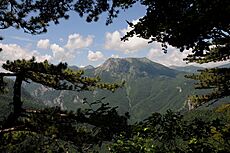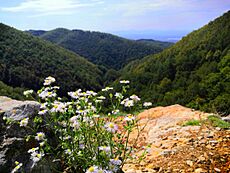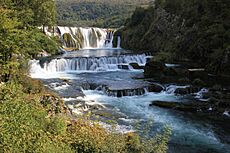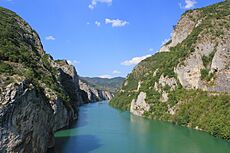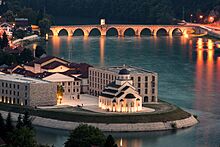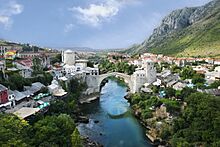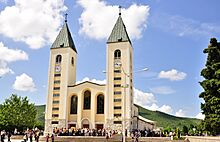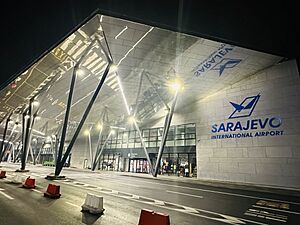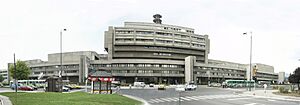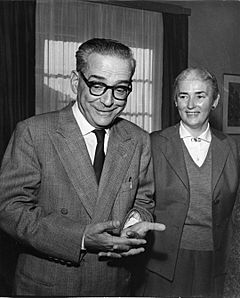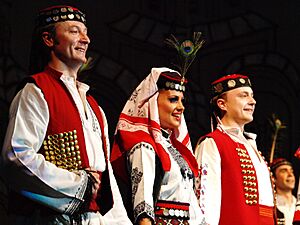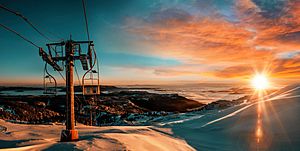Bosnia and Herzegovina facts for kids
Quick facts for kids
Bosnia and Herzegovina
|
|
|---|---|
|
Anthem: Državna himna Bosne i Hercegovine
Државна химна Босне и Херцеговине "National Anthem of Bosnia and Herzegovina" |
|
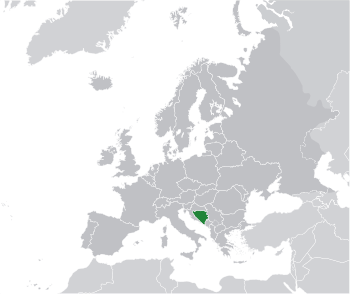
Location of Bosnia and Herzegovina (green)
on the European continent (dark grey) |
|
| Capital and largest city
|
Sarajevo 43°52′N 18°25′E / 43.867°N 18.417°E |
| Official languages | |
| Writing system | |
| Ethnic groups
(2013)
|
|
| Religion
(2013 census)
|
|
| Demonym(s) |
|
| Government | Federal parliamentary directorial republic |
|
• High Representative
|
Christian Schmidt |
| Denis Bećirović | |
| Željka Cvijanović Željko Komšić |
|
| Legislature | Parliamentary Assembly |
| House of Peoples | |
| House of Representatives | |
| Establishment history | |
|
• Bosnia (early medieval polity)
|
9th century |
|
• Banate of Bosnia
|
1154 |
|
• Kingdom of Bosnia
|
1377 |
|
• Ottoman conquest
|
1463 |
|
• Austro-Hungarian conquest and 1908 annexation
|
1878 |
|
• Creation of Yugoslavia
|
1 December 1918 |
|
• ZAVNOBiH
|
25 November 1943 |
|
• SR Bosnia and Herzegovina within SFR Yugoslavia
|
29 November 1945 |
|
• Independence from Yugoslavia
|
3 March 1992 |
|
• Washington Agreement
|
18 March 1994 |
| 14 December 1995 | |
| Area | |
|
• Total
|
51,209 km2 (19,772 sq mi) (125th) |
|
• Water (%)
|
1.4% |
| Population | |
|
• 2022 estimate
|
|
|
• 2013 census
|
3,531,159 |
|
• Density
|
69/km2 (178.7/sq mi) (156th) |
| GDP (PPP) | 2024 estimate |
|
• Total
|
|
|
• Per capita
|
|
| GDP (nominal) | 2024 estimate |
|
• Total
|
|
|
• Per capita
|
|
| Gini (2015) | ▼ 32.7 medium |
| HDI (2022) | high · 80th |
| Currency | Convertible mark (BAM) |
| Time zone | UTC+01 (CET) |
|
• Summer (DST)
|
UTC+02 (CEST) |
| Date format | d. m. yyyy. (CE) |
| Driving side | right |
| Calling code | +387 |
| ISO 3166 code | BA |
| Internet TLD | .ba |
Bosnia and Herzegovina (often called BiH) is a country in Southeastern Europe. It covers about 51,197 square kilometers. Around 3.4 million people live there.
This country shares borders with Croatia, Serbia, and Montenegro. Its capital city is Sarajevo. Other important cities include Banja Luka, Mostar, Zenica, and Tuzla.
Contents
History
The first state in Bosnia and Herzegovina appeared in the Middle Ages. Later, it became an important part of the Ottoman Empire. Sarajevo, its capital, was a large city with many people.
In 1878, the country became part of Austria-Hungary. This happened when the Empire took over Bosnia and Herzegovina in 1908. A very important event happened in Sarajevo in 1914. The Archduke Ferdinand and his wife were killed there. This event helped start World War I.
From 1918 until 1992, Bosnia and Herzegovina was part of a larger country called Yugoslavia. After a war that lasted three years, Bosnia and Herzegovina became an independent country.
Geography
Bosnia and Herzegovina is in the western Balkans. It borders Croatia to the north and west. To the east, it borders Serbia. Montenegro is to its southeast. The country has a small coastline, about 20 kilometers long, near the town of Neum.
The country's name comes from two main regions: Bosnia and Herzegovina. These regions have never had a clear border between them.
Most of the country is mountainous, with the central Dinaric Alps. The highest point is Maglić peak, which is 2,386 meters high. It is located on the border with Montenegro. Other big mountains include Volujak, Zelengora, and Jahorina. These mountains are mostly made of limestone. They also have deposits of iron, coal, and salt.
Almost half of Bosnia and Herzegovina is covered in forests. These forests are mostly in the central, eastern, and western parts of Bosnia. Herzegovina has a drier climate, similar to the Mediterranean. It has many karst landscapes, which are rocky areas shaped by water.
Northern Bosnia has very fertile land along the Sava river. This area is heavily farmed and is part of the Pannonian Plain.
Sarajevo is the capital and largest city. Other major cities are Banja Luka in the northwest and Mostar in the south.
Major Rivers
There are seven main rivers in Bosnia and Herzegovina:
- The Sava is the largest river. It forms the northern border with Croatia. This river drains most of the country's water into the Danube and then into the Black Sea.
- The Una, Sana, and Vrbas rivers flow into the Sava. They are in the northwestern part of the country.
- The Bosna river gave its name to the country. It is the longest river that stays completely within Bosnia. It flows through central Bosnia, starting near Sarajevo.
- The Drina river flows through eastern Bosnia. It forms a natural border with Serbia for much of its length.
- The Neretva is the main river of Herzegovina. It is the only major river that flows south into the Adriatic Sea.
Nature and Forests
Bosnia and Herzegovina has many different types of plants and animals. It is part of the Boreal Kingdom, which means it has northern forests. The country has four main ecoregions, including mixed forests in the Balkans and Dinaric Mountains.
About 43% of Bosnia and Herzegovina is covered by forests. This is about 2.1 million hectares of forest. Most of these forests are owned by the public.
Demography
In 1991, Bosnia and Herzegovina had about 4.3 million people. After a war in the 1990s, many people moved. This changed the population.
A census in 2013 found about 3.5 million people living in the country. This was a drop of about 20% since 1991.
Largest Cities
|
Largest municipalities in Bosnia and Herzegovina
2013 census final results |
||
|---|---|---|
| Rank | Name | Pop. |
| 1 | Sarajevo | 275,524 |
| 2 | Banja Luka | 185,042 |
| 3 | Tuzla | 110,979 |
| 4 | Zenica | 110,663 |
| 5 | Bijeljina | 107,715 |
| 6 | Mostar | 105,797 |
| 7 | Prijedor | 89,397 |
| 8 | Brčko | 83,516 |
| 9 | Doboj | 71,441 |
| 10 | Cazin | 66,149 |
Ethnic Groups
Bosnia and Herzegovina is home to three main groups of people. These are Bosniaks, Serbs, and Croats. There are also smaller groups like Jews and Roma.
According to the 2013 census, Bosniaks make up 50.1% of the population. Serbs are 30.8%, and Croats are 15.5%. Other groups make up 2.7%.
Languages
Bosnia's constitution does not name any official languages. But people use Bosnian, Croatian, and Serbian for communication. The country also recognizes many minority languages. These include Albanian, Czech, Italian, German, and Turkish.
In the 2013 census, most people (52.86%) said their mother tongue was Bosnian. About 30.76% said Serbian, and 14.6% said Croatian.
Religion
Bosnia and Herzegovina has many different religions. In 2013, about 50.7% of the people were Muslims. About 30.7% were Orthodox Christians. And 15.2% were Catholic Christians. A small number of people had no religion or followed other faiths.
Urban Areas
Sarajevo is the capital and largest city. Its urban area has about 419,957 people. The larger metro area has about 555,210 people.
Tourism
Bosnia and Herzegovina has seen a big increase in tourism. Between 1995 and 2020, it had one of the fastest tourism growth rates in the world.
In 2018, over 1.8 million tourists visited the country. Most of these visitors came from other countries.
Sarajevo is a popular city for tourists. It was ranked as one of the best cities in the world by Lonely Planet. People visit Sarajevo for its history, religious sites, and culture. It also hosted the 1984 Winter Olympics.
Međugorje is a very important place for Catholics. Many pilgrims visit it each year. Since 1981, over 30 million pilgrims have come to Međugorje.
Bosnia is also becoming popular for skiing and Ecotourism. The mountains that hosted the 1984 Winter Olympics, like Bjelašnica and Jahorina, are top skiing spots. The country has beautiful, untouched nature. This attracts adventurers and nature lovers. National Geographic called Bosnia and Herzegovina the best mountain biking place in 2012.
Whitewater rafting is also a popular activity. Rivers like the Vrbas and Tara are great for rafting. The Tara River has Europe's deepest river canyon.
Infrastructure
Transport
Sarajevo International Airport is the main airport in Bosnia and Herzegovina. It is located near the city of Sarajevo.
The country has two main railway companies. They operate trains in different parts of the country.
Telecommunications
Bosnia and Herzegovina has a modern communication system. People can use landline phones and mobile data services. High-speed internet is also available.
Many newspapers and magazines are published in the country. Some are state-owned, and others are private. The constitution protects freedom of speech.
As of 2021, Bosnia and Herzegovina had high press freedom in the region. It was ranked 58th globally. In 2021, over 3.3 million people in the country used the internet.
Education
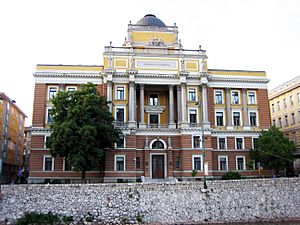

Higher education has a long history in Bosnia and Herzegovina. The first school for higher learning was a Sufi philosophy school. It was started in 1531.
The University of Sarajevo became the first modern university in the 1940s. It was damaged during the war but has been rebuilt. There are many other universities across the country. These include the University of Banja Luka and the University of Mostar.
Primary school lasts for nine years. Secondary education usually lasts four years. Students can go to general schools or technical schools. After secondary school, students can go to a university.
Culture
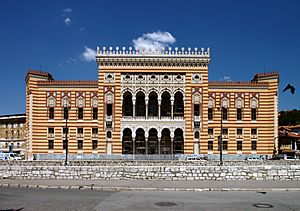
Architecture
The buildings in Bosnia and Herzegovina show influences from different time periods. Each period, with its political and social changes, added to the country's unique architectural style.
Media
Some TV channels, magazines, and newspapers are owned by the state. Others are private companies. They make money from ads and subscriptions. The country's constitution protects freedom of speech.
After the war, many groups helped rebuild and improve the media. This included setting up an independent agency to regulate communication. They also created a public broadcasting system.
Literature
Bosnia and Herzegovina has a rich history of literature. Famous writers include Nobel Prize winner Ivo Andrić. Other well-known writers are Meša Selimović and Mak Dizdar.
The National Theater was founded in Sarajevo in 1919. It is an important place for plays and performances.
Art

Art in Bosnia and Herzegovina has changed over time. It includes old medieval tombstones called Stećci. When the Austro-Hungarians arrived, painting really started to grow.
Artists like Mersad Berber and Safet Zec became very popular after World War II. In 2007, a modern art museum called Ars Aevi was opened in Sarajevo. It shows works by famous artists from around the world.
Music

Traditional Bosnian songs include ganga and rera. There is also traditional Slavic music for folk dances like kolo. From the Ottoman era, the most popular music is Sevdalinka.
Pop and Rock music are also popular. Famous musicians include Goran Bregović, Dino Merlin, and Zdravko Čolić. Many rock and pop bands from Bosnia were very popular in former Yugoslavia.
Sevdalinka is a unique Bosnian music style. These are emotional, sad folk songs. They often talk about love, loss, or heartbreak. Sevdalinkas were traditionally played with a saz, a Turkish string instrument. Now, they are often played with an accordion.
Rural folk music includes shouted, polyphonic styles. Instruments like bagpipes and wooden flutes are used. The gusle, an instrument found across the Balkans, is used to tell ancient epic poems. There are also Bosnian folk songs in the Ladino language, from the Jewish population.
Bosnian roots music comes from central Bosnia. It is usually played by singers with two violinists and a šargija player. This music is very old and passed down through families.
Cinema and Theatre
Sarajevo is known for its many festivals. The Sarajevo Film Festival started in 1995, during the war. It has become the biggest film festival in the Balkans.
Bosnia has a rich film history. Many Bosnian filmmakers have won international awards. These include Danis Tanović, who won an Academy Award for his film No Man's Land. Jasmila Žbanić won a Golden Bear for Quo Vadis, Aida?.
Cuisine
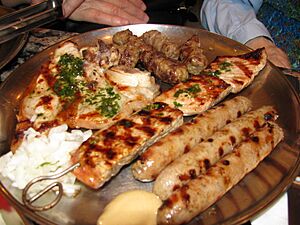
Bosnian food uses many spices, but not too much. Most dishes are light and often boiled. The sauces are natural, made from vegetable juices. Common ingredients include tomatoes, potatoes, onions, and peppers.
Bosnian food mixes influences from Western and Eastern cultures. Because of the long Ottoman rule, it is similar to Turkish and Greek food. But Austrian rule also brought influences from Central Europe.
Typical meat dishes use beef and lamb. Some local specialties are ćevapi, burek, and dolma. Ćevapi is a grilled minced meat dish. It is considered a national dish.
Local wines come from Herzegovina, where grapes grow well. Plum or apple alcoholic drinks are made in the north.
Coffeehouses are very common. Bosnian coffee is served in a special pot called a džezva. Coffee drinking is a favorite Bosnian pastime. Bosnia and Herzegovina is one of the top countries in the world for coffee drinking.
Sports
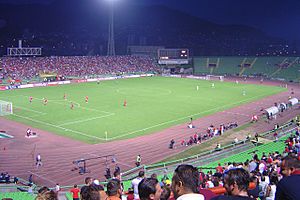
Bosnia and Herzegovina has many great athletes. The most important sports event was the 1984 Winter Olympics, held in Sarajevo.
The Borac handball club has won many championships. They won the European Cup in 1976.
Amel Mekić, a judoka, became European champion in 2011. Track and field athlete Amel Tuka won medals in the 800 meters at world championships.
The Bosna Royal basketball club from Sarajevo won the European Champions title in 1979. Many Bosnian players were part of the successful Yugoslav national basketball team. Today, players like Mirza Teletović and Jusuf Nurkić play for Bosnia and Herzegovina. The national under-16 team won two gold medals in 2015.
The Bosnian chess team has won many titles. They were champions of Yugoslavia seven times. They also placed second at the Chess Olympiad in 1994.
Association football is the most popular sport. Bosnian clubs like FK Sarajevo and Željezničar won Yugoslav championships. The Bosnia and Herzegovina national football team played in the 2014 FIFA World Cup. Famous players include Edin Džeko and Miralem Pjanić.
The national sitting volleyball team is one of the best in the world. They have won many European and World Championships. They also won two Paralympic gold medals.
Tennis is also becoming popular. Players like Damir Džumhur and Mirza Bašić have had success at Grand Slam tournaments.
Related pages
- Bosnia and Herzegovina at the Olympics
- Bosnia and Herzegovina national football team
- List of rivers of Bosnia and Herzegovina
Images for kids
-
Gazi Husrev-beg Mosque in Sarajevo, built in 1531
-
The breakup of Yugoslavia
-
Tuzla government building burning after anti-government protests on 7 February 2014
-
The Central Bank of Bosnia and Herzegovina in Sarajevo
-
Edin Džeko, captain of the Bosnian national football team
See also
 In Spanish: Bosnia y Herzegovina para niños
In Spanish: Bosnia y Herzegovina para niños




